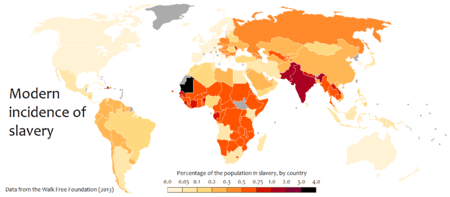Debt bondage in India

Debt bondage in India or Bandhua Mazdoori (बंधुआ मज़दूरी) was legally abolished in 1976 but it remains prevalent, with weak enforcement of the law by governments.[1] Bonded labour involves the exploitive interlinking of credit and labour agreements that devolve into slave-like exploitation due to severe power imbalances between the lender and the borrower.[1]
The rise of Dalit activism, government legislation starting as early as 1949,[2] as well as ongoing work by NGOs and government offices to enforce labour laws and rehabilitate those in debt, appears to have contributed to the reduction of bonded labour in India. However, according to research papers presented by the International Labour Organization, there are still many obstacles to the eradication of bonded labour in India.[3][4]
Debt bondage
It is estimated by Siddharth Kara that 84 to 88% of the bonded laborers in the world are in South Asia.[5] Debt bondage in India is most prevalent in agricultural areas. Farmers taking small loans can find themselves paying interest on the loans that exceeds 100% of the loan per year.[1]
Children
The presence of a large number of child labourers is regarded as a serious issue in terms of economic welfare.[6] A form of long run employer-slave relationship is formed when these children are tied to this debt bondage to work for their employers for a time period that could be stretched to a lifetime, and usually for minimal or no wages.[7]
Estimates
Estimates of the problem vary. Official figures include a 1993 estimate of 251,000 bonded labourers, [8] while the Bandhua Mukti Morcha says there are over 20 million bonded labourers. A 2003 project by Human Rights Watch has reported a major problem with bonded child labour in the silk industry.[9]
Contributing factors
Author and academic Siddharth Kara believes that:-
| “ | Bonded labour is a relic of history that should have long ago been eliminated from South Asia, but greed, corruption, and government ineffectiveness allow this caustic mode of exploitation to persist well into modern times. In order to ensure basic human rights, guarantee untainted global supply chains, and protect international security, the forces that promote bonded labour must be tackled immediately.[1] | ” |
See also
- Bonded Labour Liberation Front
- Debt Conciliation Board
- Farmers' suicides in India
- Indian black money
- Kisan Credit Card
- Siddharth Kara
- Bonded Labour System (Abolition) Act, 1976
General:
Further reading
- Knight, Sarah (2012). "Debt-Bondage Slavery in India".
References
- 1 2 3 4 "A $110 loan, then 20 years of debt bondage". CNN. June 2, 2011.
- ↑ Hart, Christine Untouchability Today: The Rise of Dalit Activism, Human Rights and Human Welfare, Topical Research Digest 2011, Minority Rights
- ↑ "International Dalit Solidarity Network: Key Issues: Bonded Labour".
- ↑ Ravi S. Srivastava Bonded Labor in India: Its Incidence and Pattern InFocus Programme on Promoting the Declaration on Fundamental Principles and Rights at Work; and International Labour Office,(2005). Forced Labor. Paper 18
- ↑ Kara, Siddharth (2012). Bonded Labor: Tackling the System of Slavery in South Asia. New York: Columbia University Press. ISBN 9780231158480.
- ↑ "Magnitude of Child Labour in India" (PDF).
- ↑ "Incidence and Pattern" (PDF).
- ↑ "Statement by observer for India to the United Nations Working Group on Contemporary Forms of Slavery (para 81), report". Retrieved September 7, 2006.
- ↑ "SMALL CHANGE: Bonded Child Labor in India's Silk Industry". Human Rights Watch. January 2003. Retrieved September 7, 2006.
